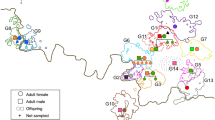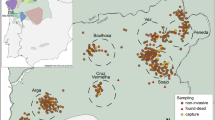Abstract
Matings between close relatives often reduce the fitness of offspring, probably because homozygosity leads to the expression of recessive deleterious alleles1,2,3,4,5. Studies of several animals have shown that reproductive success is lower when genetic similarity between parents is high4,5,6,7, and that survival and other measures of fitness increase with individual levels of genetic diversity8,9,10,11. These studies indicate that natural selection may favour the avoidance of matings with genetically similar individuals. But constraints on social mate choice, such as a lack of alternatives, can lead to pairing with genetically similar mates. In such cases, it has been suggested that females may seek extra-pair copulations with less related males4, but the evidence is weak or lacking4,5. Here we report a strong positive relationship between the genetic similarity of social pair members and the occurrence of extra-pair paternity and maternity (‘quasi-parasitism’) in three species of shorebirds. We propose that extra-pair parentage may represent adaptive behavioural strategies to avoid the negative effects of pairing with a genetically similar mate.
This is a preview of subscription content, access via your institution
Access options
Subscribe to this journal
Receive 51 print issues and online access
$199.00 per year
only $3.90 per issue
Buy this article
- Purchase on Springer Link
- Instant access to full article PDF
Prices may be subject to local taxes which are calculated during checkout

Similar content being viewed by others
References
van Noordwijk, A. J. & Scharloo, W. Inbreeding in an island population of the great tit. Evolution 35, 674–688 (1981)
Thornhill, N. W. (ed.) The Natural History of Inbreeding and Outbreeding (Univ. Chicago Press, Chicago, 1993)
Jiménez, J. A., Hughes, K. A., Alaks, G., Graham, L. & Lacy, R. C. An experimental study of inbreeding depression in a natural habitat. Science 266, 271–273 (1994)
Bensch, S., Hasselquist, D. & von Schantz, T. Genetic similarity between parents predicts hatching failure: non-incestuous inbreeding in the great reed warbler? Evolution 48, 317–326 (1994)
Kempenaers, B., Adriaensen, F., van Noordwijk, A. J. & Dhondt, A. A. Genetic similarity, inbreeding and hatching failure in blue tits: are unhatched eggs infertile? Proc. R. Soc. Lond. B 263, 179–185 (1996)
Olsson, M. & Madsen, T. Promiscuity in sand lizards (Lacerta agilis) and adder snakes (Vipera berus): Causes and consequences. J. Hered. 92, 190–197 (2001)
Tregenza, T. & Wedell, N. Polyandrous females avoid costs of inbreeding. Nature 415, 71–73 (2002)
Amos, W. et al. The influence of parental relatedness on reproductive success. Proc. R. Soc. Lond. B 268, 2021–2028 (2001)
Coltman, D. W., Bowen, W. D. & Wright, J. M. Birth weight and neonatal survival of harbour seal pups are positively correlated with genetic variation measured by microsatellites. Proc. R. Soc. Lond. B 265, 803–809 (1998)
Coulson, T. N. et al. Microsatellites reveal heterosis in red deer. Proc. R. Soc. Lond. B 265, 489–495 (1998)
Hansson, B., Bensch, S., Hasselquist, D. & Åkesson, M. Microsatellite diversity predicts recruitment of sibling great reed warblers. Proc. R. Soc. Lond. B 268, 1287–1291 (2001)
Petrie, M. & Kempenaers, B. Extra-pair paternity in birds: explaining variation between species and populations. Trends Ecol. Evol. 13, 52–58 (1998)
Jennions, M. D. & Petrie, M. Why do females mate multiply? A review of the genetic benefits. Biol. Rev. 75, 21–64 (2000)
Westneat, D. F. & Sherman, P. W. Density and extra-pair fertilizations in birds: a comparative analysis. Behav. Ecol. Sociobiol. 41, 205–215 (1997)
Alves, M. A. S. & Bryant, D. M. Brood parasitism in the sand martin, Riparia riparia: evidence for two parasitic strategies in a colonial passerine. Anim. Behav. 56, 1323–1331 (1998)
Wallander, J., Blomqvist, D. & Lifjeld, J. T. Genetic and social monogamy—does it occur without mate guarding in the ringed plover? Ethology 107, 561–572 (2001)
Brooker, M. G., Rowley, I., Adams, M. & Baverstock, P. R. Promiscuity: an inbreeding avoidance mechanism in a socially monogamous species? Behav. Ecol. Sociobiol. 26, 191–199 (1990)
Stockley, P., Searle, J. B., Macdonald, D. W. & Jones, C. S. Female multiple mating behaviour in the common shrew as a strategy to reduce inbreeding. Proc. R. Soc. Lond. B 254, 173–179 (1993)
Brown, J. L. A theory of mate choice based on heterozygosity. Behav. Ecol. 8, 60–65 (1997)
Hasselquist, D., Bensch, S. & von Schantz, T. Correlation between male song repertoire, extra-pair paternity and offspring survival in the great reed warbler. Nature 381, 229–232 (1996)
Kempenaers, B. et al. Extra-pair paternity results from female preference for high-quality males in the blue tit. Nature 357, 494–496 (1992)
Petrie, M., Krupa, A. & Burke, T. Peacocks lek with relatives even in the absence of social and environmental cues. Nature 401, 155–157 (1999)
Höglund, J., Alatalo, R. V., Lundberg, A., Rintamäki, P. T. & Lindell, J. Microsatellite markers reveal the potential for kin selection on black grouse leks. Proc. R. Soc. Lond. B 266, 813–816 (1999)
Shorey, L., Piertney, S., Stone, J. & Höglund, J. Fine-scale genetic structuring on Manacus manacus leks. Nature 408, 352–353 (2000)
del Hoyo, J., Elliott, A. & Sargatal, J. (eds) Handbook of the Birds of the World, Vol. 3. Hoatzin to Auks (Lynx Edicions, Barcelona, 1996)
Carter, R. E. Molecular Methods in Ecology (ed. Baker, A. J.) 113–135 (Blackwell Science, Oxford, 2000)
Shin, H.-S., Bargiello, T. A., Clark, B. T., Jackson, F. R. & Young, M. W. An unusual coding sequence from a Drosophila clock gene is conserved in vertebrates. Nature 317, 445–448 (1985)
Westneat, D. F. Polygyny and extrapair fertilizations in eastern red-winged blackbirds (Agelaius phoeniceus). Behav. Ecol. 4, 49–60 (1993)
Griffiths, R., Double, M. C., Orr, K. & Dawson, R. J. G. A DNA test to sex most birds. Mol. Ecol. 7, 1071–1075 (1998)
Ellegren, H. & Fridolfsson, A.-K. Male-driven evolution of DNA sequences in birds. Nature Genet. 17, 182–184 (1997)
Acknowledgements
We thank J. Lifjeld for scoring fingerprints; D. Hasselquist, A. Johnsen, K. Lessells, B. Sheldon and R. Wagner for comments on the manuscript; and U. Bläsi, I. Moll and K. Carter for logistic support. The study was supported by the Konrad Lorenz Institute for Comparative Ethology, Vienna, and by grants from the Natural Environment Research Council UK, the Hungarian Scientific Research Fund and the Swedish Research Council.
Author information
Authors and Affiliations
Corresponding author
Ethics declarations
Competing interests
The authors declare that they have no competing financial interests.
Rights and permissions
About this article
Cite this article
Blomqvist, D., Andersson, M., Küpper, C. et al. Genetic similarity between mates and extra-pair parentage in three species of shorebirds. Nature 419, 613–615 (2002). https://doi.org/10.1038/nature01104
Received:
Accepted:
Issue Date:
DOI: https://doi.org/10.1038/nature01104
This article is cited by
-
Evolution of reproductive strategies: sex roles, sex ratios and phylogenies
Biologia Futura (2023)
-
Extra-pair paternity in a species with frequent extra-pair courtship feedings, few extra-pair copulations, and male-biased parental care
Journal of Ornithology (2022)
-
High level of extra-pair paternity in the socially monogamous Marsh Tits (Poecile palustris)
Avian Research (2021)
-
Evolution of female promiscuity in Passerides songbirds
BMC Evolutionary Biology (2019)
-
An experimental increase in female mass during the fertile phase leads to higher levels of extra-pair paternity in pied flycatchers Ficedula hypoleuca
Behavioral Ecology and Sociobiology (2019)
Comments
By submitting a comment you agree to abide by our Terms and Community Guidelines. If you find something abusive or that does not comply with our terms or guidelines please flag it as inappropriate.



